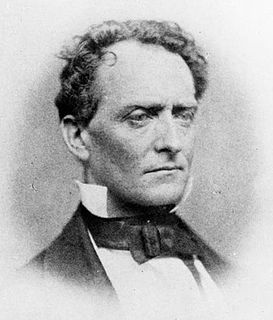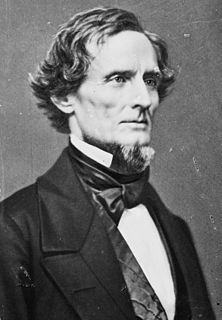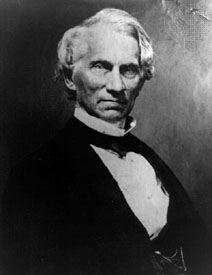
The Confederate States of America (CSA), commonly referred to as the Confederate States or the Confederacy, was an unrecognized breakaway state in existence from February 8, 1861, to May 9, 1865, that fought against the United States of America during the American Civil War. The eleven states that seceded from the Union and formed the main part of the CSA were South Carolina, Mississippi, Florida, Alabama, Georgia, Louisiana, Texas, Virginia, Arkansas, Tennessee, and North Carolina.

The Constitution of the Confederate States was the supreme law of the Confederate States of America. It was adopted on March 11, 1861, and was in effect from February 22, 1862, to the conclusion of the American Civil War. The Confederacy also operated under a Provisional Constitution from February 8, 1861, to February 22, 1862. The original Provisional Constitution is located at the American Civil War Museum in Richmond, Virginia, and differs slightly from the version later adopted. The final, handwritten Constitution is located in the University of Georgia archives. Most of its provisions are word-for-word duplicates from the United States Constitution; however, there are crucial differences between the two documents in tone and legal content, primarily regarding slavery.

The Confederate States Navy (CSN) was the naval branch of the Confederate States Armed Forces, established by an act of the Confederate States Congress on February 21, 1861. It was responsible for Confederate naval operations during the American Civil War against the United States's Union Navy.

The Confederate States Army, also called the Confederate Army or simply the Southern Army, was the military land force of the Confederate States of America during the American Civil War (1861–1865), fighting against the United States forces in order to uphold the institution of slavery in the Southern states. On February 28, 1861, the Provisional Confederate Congress established a provisional volunteer army and gave control over military operations and authority for mustering state forces and volunteers to the newly chosen Confederate president, Jefferson Davis. Davis was a graduate of the U.S. Military Academy, and colonel of a volunteer regiment during the Mexican–American War. He had also been a United States Senator from Mississippi and U.S. Secretary of War under President Franklin Pierce. On March 1, 1861, on behalf of the Confederate government, Davis assumed control of the military situation at Charleston, South Carolina, where South Carolina state militia besieged Fort Sumter in Charleston harbor, held by a small U.S. Army garrison. By March 1861, the Provisional Confederate Congress expanded the provisional forces and established a more permanent Confederate States Army.

Robert Ward Johnson was an American planter and lawyer who served as the senior Confederate States senator for Arkansas, a seat that he was elected to in 1861. He previously served as a delegate from Arkansas to the Provisional Congress of the Confederate States from 1861 to 1862.

In the context of the American Civil War (1861–65), the border states were slave states that did not secede from the Union. They were Delaware, Maryland, Kentucky, and Missouri, and after 1863, the new state of West Virginia. To their north they bordered free states of the Union and to their south they bordered Confederate slave states.

The Territory of Arizona was a territory of the United States that existed from February 24, 1863, until February 14, 1912, when the remaining extent of the territory was admitted to the Union as the state of Arizona. It was created from the western half of the New Mexico Territory during the American Civil War.

Confederate Arizona, officially the Territory of Arizona, and commonly known as the Arizona Territory was an organized incorporated territory of the Confederate States that existed from August 1, 1861, until May 26, 1865, when the Trans-Mississippi Department, commanded by General E. Kirby Smith, surrendered at Shreveport, Louisiana. Effective Confederate control of Arizona Territory, however, ended after the Battle of Glorieta Pass in March 1862.

The president of the Confederate States was the head of state and head of government of the Confederate States. The president was the chief executive of the federal government and was the commander-in-chief of the Confederate Army and the Confederate Navy.

The Confederate States Congress was both the provisional and permanent legislative assembly of the Confederate States of America that existed from 1861 to 1865. Its actions were for the most part concerned with measures to establish a new national government for the Southern "revolution", and to prosecute a war that had to be sustained throughout the existence of the Confederacy. At first, it met as a provisional congress both in Montgomery, Alabama and Richmond, Virginia.

The Provisional Congress of the Confederate States, also known as the Provisional Congress of the Confederate States of America, was a congress of deputies and delegates called together from the Southern States which became the governing body of the Provisional Government of the Confederate States from February 4, 1861, to February 17, 1862. It sat in Montgomery, Alabama, until May 21, 1861, when it adjourned to meet in Richmond, Virginia, on July 20, 1861. It added new members as other states seceded from the Union and directed the election on November 6, 1861, at which a permanent government was elected.

The Seal of the Confederate States was used to authenticate certain documents issued by the federal government of the Confederate States. The phrase is used both for the physical seal itself, and more generally for the design impressed upon it. On May 20, 1863, C.S. Secretary of State Judah Benjamin instructed James Mason to arrange for its manufacture in London. The seal was first used publicly in 1864.

Christopher Gustavus Memminger was a German-born American politician and a secessionist who participated in the Confederate States. He was the principal author of the Provisional Constitution (1861) as well as the founder of the Confederate financial system. As the first Confederate States Secretary of the Treasury, Memminger was the main author of the economic policies of Jefferson Davis's administration.
The Provisional Constitution of the Confederate States, formally the Constitution for the Provisional Government of the Confederate States of America, was an agreement among all seven original states in the Confederate States of America that served as its first constitution. Its drafting by a committee of twelve appointed by the Provisional Congress began on February 5, 1861. The Provisional Constitution was formally adopted on February 8. Government under this constitution was superseded by the new Constitution of the Confederate States with a permanent form of government "organized on the principles of the United States" on February 22, 1862.

Charles Burton Mitchel was an American politician who served as a Confederate States Senator from Arkansas from February 18, 1862 until his death in 1864. A member of the Democratic Party, he represented Arkansas as a U.S. Senator in 1861.

The Vice-President of the Confederate States was the second highest executive officer of the government of the Confederate States of America and the deputy to the President of the Confederate States. The office was held by Alexander H. Stephens of Georgia, who served under President Jefferson Davis of Mississippi from February 18, 1861, until the dissolution of the Confederacy on May 5, 1865. Having first been elected by the Provisional Confederate States Congress, both were considered provisional office-holders until they won the presidential election of November 6, 1861 without opposition and inaugurated on February 22, 1862.

The Confederate States Secretary of War was a member of President Jefferson Davis's Cabinet during the American Civil War. The Secretary of War was head of the Confederate States Department of War. The position ended in May 1865 when the Confederacy crumbled during John C. Breckinridge's tenure of the office.

The Confederate government of Kentucky was a shadow government established for the Commonwealth of Kentucky by a self-constituted group of Confederate sympathizers during the American Civil War. The shadow government never replaced the elected government in Frankfort, which had strong Union sympathies. Neither was it able to gain the whole support of Kentucky's citizens; its jurisdiction extended only as far as Confederate battle lines in the Commonwealth. Nevertheless, the provisional government was recognized by the Confederate States of America, and Kentucky was admitted to the Confederacy on December 10, 1861. Kentucky, the final state admitted to the Confederacy, was represented by the 13th (central) star on the Confederate battle flag.

The Confederate States presidential election of November 6, 1861, was the only presidential election held under the Permanent Constitution of the Confederate States of America. Jefferson Davis, who had been elected president and Alexander H. Stephens, who had been elected vice president, under the Provisional Constitution, were elected to six-year terms as the Confederate States' first permanent president and vice president.

This article is a list of national symbols of the Confederate States enacted through legislation. Upon its independence on February 8, 1861, and subsequent foundation of the permanent government on February 22, 1862, the Confederate States Congress adopted national symbols distinct from those of the United States.















